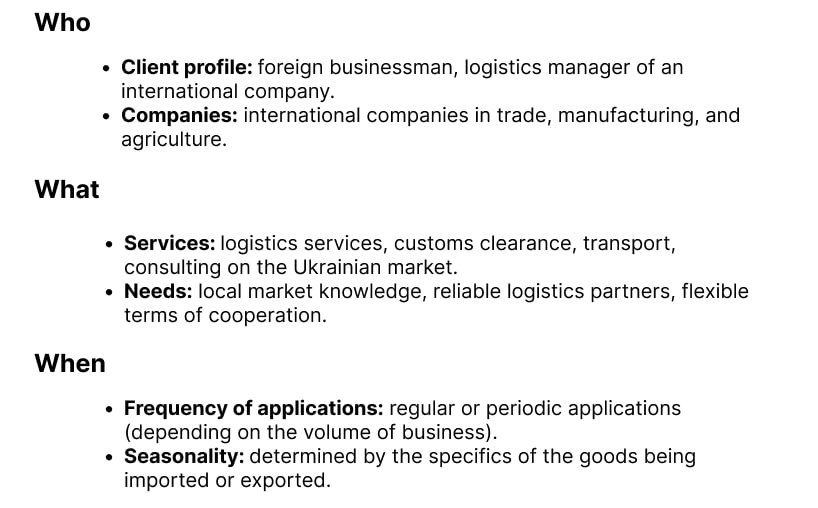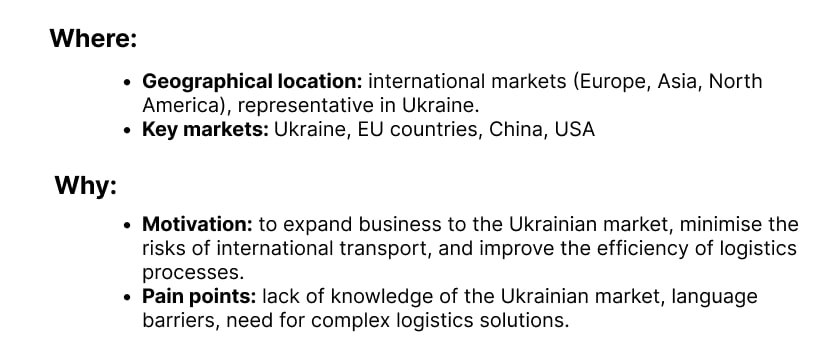Safelogic is a company that really knows what logistics is all about. They transport goods around the world, offer comprehensive solutions, and work quickly and efficiently. But there was one thing: customers came irregularly and chaotically.
“We want to increase the number of middle segment customers (from 2 to 49 containers per month) and gradually move customers to the premium class (50+ containers), but we don’t know how to do it exactly.”
Outdated website, inactive social media, no advertising. Safelogic turned to Solve Marketing to fix it
| How long did it take to develop the strategy? | 80 hours, 4 working weeks |
| What is the team composition for developing a marketing strategy? | Head of Marketing Team, Head of Content Team, project manager, operational marketer, marketing assistant, content marketer, head of PPC, Facebook PPC. |
| How was the result of the work used? | We started implementing the strategy as a remote marketing department. |
The market is growing, but challenges remain
After a briefing and detailed interviews, we plunged into market research. A few years ago, logistics in Ukraine was stable. But after 2022, the game changed: routes were closed, costs increased, and companies started looking for new solutions.
Imagine that suddenly all the familiar roads in your city became inaccessible and you had to look for new, unknown routes that no one had ever travelled before. This is exactly what the logistics business is feeling right now.
But the demand for logistics services remains consistently high. Ukrainian businesses are adapting, looking for solutions, and testing new models. We conducted an in-depth market analysis and found several key trends:
- Maritime logistics is back, but with new rules. The alternative maritime corridor has even allowed exports of grain and metals to increase compared to the period of the official “grain agreement”.
- Road transport has become a priority, although it faces queues and blockades.
- Multimodal transport is the new standard, where companies combine different modes of transport
🚛+🚆
🚢+🚛 - Automation and algorithms have become an integral part of efficient logistics: artificial intelligence that optimises routes, predicts delays and builds the best supply chains.
Logistics market in Ukraine
| ⬇️ | ⬇️ |
| International corporations: resources, scale and customer trust | Local companies: flexibility, adaptation to changes and individual approach |
The main challenge for local companies is not just to compete with the price, but with the service, speed of delivery and efficiency of solutions.
And the identified trends are development vectors for Safelogic:
- Focus on multimodal logistics.
- Working with import and export markets — demand for goods from China, Poland, and Germany is growing.
- Innovations as a key advantage — AI is also conquering logistics.
The logistics market is changing. And those who adapt quickly become its future leaders. But this requires a strategy.
Market analysis is the objective collection of information and the construction of expert opinions that can be applied in practice.
In the case study, we have shown only a small part of the full market analysis. Want to know what solutions will help your business grow?
Who plays in the logistics market and how…
When entering the market, it is important to understand which companies have already established themselves in your niche, have customers and are able to attract new ones.
We dived deeper
After a detailed market analysis, we analysed competitors in detail. We studied the websites, social networks, reviews, promotion channels, and positioning of the following key players: Mitridat, Marline, UkraMarine, Global Ocean Link, Corcel, Supramarine, Inter Trans Logistic.
All companies have a different approach to marketing. Some invest in social media, others in the personal brand of their managers. But we were interested in the strongest ones.
This is what we saw:
| Global Ocean Link | is building the No. 1 image in multimodal transport through industry events and an active digital presence. |
| Inter Trans Logistic | leaders of online services with the first chatbots for cargo tracking in the niche |
| Mitridat | is actively working on its reputation through ratings, awards and social media. |
The analysis also helped us to explore development trends in most companies. Therefore, these are the vectors that are worth paying attention to:
- Bet on the team: photos, videos in social networks and on the website.
- Bet on B2B communities: started working with business associations or are listed in industry rankings and media.
- They are actively developing their websites to attract SEO traffic.
- Targeted advertising on Facebook and Google.
At this stage, it was too early to draw conclusions, as we had an important step of competitor analysis ahead of us:
Research of competitors’ sales departments: “Mystery Shopper“
Imagine: you are looking for a carrier, send a request and… silence. An hour passes. Three. A day. And when the answer finally comes, it resembles a set of standard phrases: “Let’s clarify”, “This is a question for a partner”, “Contact us later”.
Now imagine a different situation: a few minutes after your request, a manager calls you. He understands your task, offers several options, answers all your questions, and keeps in touch even after sending an offer. Can you feel the difference?
To check how communication works in a niche, we conducted a study in the format of a “mystery shopper”. We sent the same request and evaluated the speed of response, the quality of communication, and the completeness of the offer.
The results surprised us:
- Some companies responded in a few minutes, while others took several days.
- Some sent a clear offer, while others — just numbers without explanation.
- Some companies kept in touch after the first contact, while others simply disappeared.
We collected the detailed information in a word file and created a table for easy comparison:

Most companies compete on price. But the winners are those who build trust and expertise. This has become the key to Safelogic’s marketing strategy, and it’s how the company will gain not just customers, but long-term partners.
And this is where marketing comes into play. A strategy is a well-thought-out system where each element works for a specific integrated result. After all, logistics is not only about cargo delivery, but also about trusted service.
A free consultation is the first step towards systematic growth of your business.Outdated website, inactive social media, no advertising. Safelogic turned to Solve Marketing to fix it
How we built lead generation: from hypotheses to a systematic approach
In logistics, you don’t buy on emotion, like a cup of coffee. It is a long decision-making process where trust, clarity of service and quality of communication play a key role.
We analysed the possibilities in detail, investigated the risks and feasibility of Google and Meta advertising.
And based on this data, we have planned the optimal advertising budget, provided references, and built a step-by-step promotion plan that shows the real amount of work. So that you can choose whether to invest your own resources or entrust the launch to the Solve Marketing team, who know how to do it quickly and efficiently.
An example of a media plan:

It is important to note that advertising only attracts the attention of potential customers. Without a high-quality website that inspires trust and encourages them to leave a request, advertising traffic will remain just that — traffic.
A website is your online representation. Imagine that a large customer who is used to paying for service comes to your office. If it’s a modern, spacious office in the city centre, it inspires confidence and reinforces your image. If it’s a single room in the suburbs, the effect will be completely different. The same is true for websites: a multi-page, well-thought-out resource creates a sense of reliability, while simple landing pages are used for mass products where the main advantage is price.
Simple one-page websites are effective if your product is targeted at a wide market and your competitive advantage is price. However, in complex niches, advertising tools are of secondary importance. Your brand and its packaging, of which your website is a part, come first.
How to turn likes into customers
Social media used to be just a platform for news and updates. Now it’s a full-fledged customer engagement tool. The key question is: are they being used to their full potential?
Our content marketer plunged into a social media audit: he analysed the content, audience behaviour, and frequency of posts.
One of the insights is that:
🔹 Team videos and memes are the real champions of engagement. People want to see live stories, meet real faces, and feel emotions even in logistics. However, many companies still run social media in a dry way: text posts without interactivity and calls to action.
As part of the marketing strategy, the marketer analysed technical indicators such as traffic, promotion, and content effectiveness in detail. Based on this analysis, content recommendations were made: the optimal formats, frequency of publications, key headings, and topics that would help attract potential customers were identified.
Posting content is not enough. It is important to make it engaging, trustworthy, and, most importantly, sellable. Social media is just one of the tools that works for results. Do you want social media to bring you customers, not just likes? Let’s discuss how to build a strategy that works!
Choice factors — a unique Solve Marketing framework
Working with the choice factors framework allows you to clearly understand what exactly influences a customer’s decision. This method helps to identify key messages for social media, create a strategic backlog — a clear promotion plan, understand the points of interaction with the audience, and improve the customer experience.
For Safelogic, we compiled a list of more than 140 choice factors and identified which ones would help create demand for this product. Each of these factors can be transformed into a specific task for implementation, and the combination of implemented choice factors leads to the achievement of strategic results. How it looks like:

SWOT analysis
When a company has a clear understanding of its strengths and weaknesses, seizes opportunities and works on risks, it creates a more stable approach from a marketing perspective because we know what to look for. We dove into Safelogic’s analysis from this perspective to see where there is room for development and which solutions will have the fastest impact.

Audience needs
We conducted a detailed audience segmentation: who are the potential customers, what are their “pains”, what motivates them to make decisions?
✅ We identified the main groups of customers by their needs, identified key barriers and expectations for each segment, described motivation and created specific marketing tools: what messages to use, what channels to use, what content will work for each segment
An example of a description of one of the segments:
What is audience segmentation for? Each client should receive a message aimed at their segment.
For example, an export-oriented business owner will see a case study showing how their colleagues have optimized logistics.
And international customers will see an ad that works with their fears about transportation to Ukraine.
No random messages — just a targeted, thoughtful approach.
From raw stone to crystal: how we created positioning that works
In the world of logistics, where most companies use the same phrases, it is important to find something truly unique. “A reliable partner in international transportation” sounds familiar, doesn’t it? But does it make a customer choose you? Hardly.
That’s why we approached the task like jewelers polishing a precious stone. We analyzed competitors, customer choice factors, and internal processes of the company — all of these became our tools. We researched, tested, and compared to find the true value that convinces and sells.
We developed the positioning in several iterations. The first concepts we brought to the owner for consideration did not resonate. And that’s okay, because the positioning either resonates with the team, is accepted and used. Or it doesn’t resonate, and then, at best, it just becomes a phrase that no one believes in.
We work on the principle of finding a concept that makes the team exclaim: “Yes! This is about us! This is us!”. And if the first concepts don’t strike a chord, we dig deeper.
From the very beginning, it was obvious: Safelogic doesn’t just transport goods. The company gives customers control over costs and delivery times. It’s not about “we’re the best,” it’s about real business benefits. But how to convey this in a simple, clear, and convincing way?
In the end, we found something that not only resonated with the team and the business owner. We found the essence of this business and formulated it in short and truthful words:
| 😳 Before ⬇️ | ✅ After ⬇️ |
|---|---|
| Safelogic — safe and timely delivery of your goods to their destination. | Safelogic – we transport containers with care for the people waiting for them. |
The key is not to invent something artificial, but to see the real value that already exists but is not fully utilized. It’s not just about logistics, it’s about responsibility, trust, and confidence that the cargo will arrive on time and that business customers will be able to build stable processes.
Finding the right words is only the first step. For positioning to really work, it needs to be integrated into all communication: from the website and marketing materials to social media, presentations, and even conversations between managers and customers. This is the only way to make a brand recognizable, understandable, and trustworthy at every stage of interaction.
Positioning is also the foundation for developing a brand book: corporate colors, logo, fonts. This is how we understand what meanings to convey and how to create the right associations.
Hypotheses
We do not view marketing in isolation from the business — instead, we build a holistic system where each element works towards a common result. Therefore, when creating a strategy, we cover everything from clear positioning to effective customer acquisition and retention.
After a detailed analysis of the market, competitors, and current processes, we developed 10 marketing hypotheses that will help businesses scale and build long-term relationships with customers.
One of these hypotheses is:
📌 The introduction of a chatbot for delivery tracking and a personal account will increase the level of trust, reduce the outflow of mid-market customers by 20% and stimulate repeat business. This means that the company does not just reduce costs, it turns them into new opportunities by increasing the number of transactions and recommendations.
However, in competitive niches, it is vital to create a sequence of customer touches.
Therefore, to achieve the result, you need a set of actions and tools:
— A multi-page website with a blog to generate SEO traffic and increase customer trust.
— Regular posting on social media as an indicator of presence and active work, as well as for additional touches with the audience.
— Several advertising tools that work all the time: Google, Meta.
It takes time for a customer in the logistics services industry to decide to contact a company: sometimes several weeks, sometimes several months.
Therefore, an increase in the number of touches directly affects the likelihood that a customer will reach the stage of contact.
You shouldn’t expect that a set of simple actions, such as creating a landing page and running ads on a small test budget, will give you a quick result in complex b2b topics.
In this case study, we share the experience of more than two years of cooperation, during which we managed to build a marketing department from scratch and achieve 150+ leads per month. Therefore, we know from our own experience that for b2b businesses in complex niches, marketing is a long game.
Accordingly, the strategy we develop contains a list and sequence of actions to achieve results. The main thing is to understand at the start that this result will not be quick.
Marketing in logistics — is not just about numbers
It’s about trust, expertise and speed of response. Therefore, we have developed a system that covers all stages of interaction: from the first contact to customer loyalty.
The result is a comprehensive strategy that not only attracts customers but also helps the company grow. The next step is to implement and scale it. Ready to make your results systematic and predictable? Fill out the questionnaire to implement systematic marketing and strategic objectives in your business!
If a strategy really works, it can’t just be put aside — it requires action.
That’s why, after developing the strategy, we moved on to its implementation. After all, marketing is not a one-off event, but an ongoing process: testing hypotheses, adapting to changes, analysing data and scaling.
What happened next? That’s a whole other story. But it’s definitely worth reading 😉 Details here.







